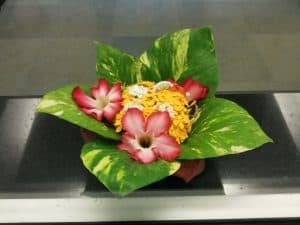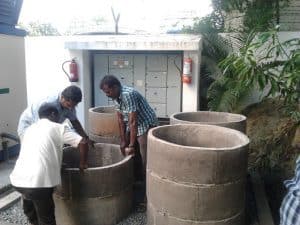At Sabari Terrace, an apartment community with 56 flats off the Old Mahabalipuram Road (OMR) in Sholinganallur, we took the first steps towards segregation around five years ago. It started with the creation of a few humble compost pits within our premises – cement rings resting on the ground – where we would dump all our garden waste to begin with. We approached the guru of vermicomposting, Dr. Sultan Ahmed Ismail, and under his guidance started the process of composting our garden waste.
Gradually over the next few weeks, months and years, we started approaching the families in the community, asking them to share their uncooked vegetable waste from the kitchen whenever they could. It was not easy to convince them as most considered “segregation” a pain.
What made this particularly challenging in our community was the fact that we have only 12 families residing here while the rest of the flats are mostly commercial properties – service apartments or guest houses belonging to private enterprises – and hence house a floating population, more reliant on their pizzas and ‘take outs’ and ‘deliveries’. This challenge is something that we are grappling with even now, though we have made some progress as I shall elaborate upon later.
Eventually, we also hit upon a plan to prevent our recyclable waste from ending up in the landfills. We instructed our housekeeping staff to segregate all the pizza boxes, paper cartons, plastic and beer bottles etc from the garbage they collected from the flats and dump these in a spare, big garbage bin that the builder had left behind.
Periodically they would sell the waste thus accumulated to the local kabadiwalla and share the proceeds among themselves, as a result of which they were now taking home more than their monthly salary. This has naturally given them an incentive to follow this process meticulously and in a sustained manner.
We are far from enforcing 100% waste segregation at Sabari Terrace, but thanks to the above steps, we can rightfully claim to have significantly reduced the amount of waste collected by the municipality for the dumps. It is an ongoing journey, but here are a few things that I have gleaned from this and would like to share:
1. There are ways to convince people, and there are ways…
Most people ‘throw’ away their waste but when you ask them for it, it becomes the most precious thing in their lives! They think we are going to become millionaires by taking their waste and they want to be compensated for it!
I recall a dialogue in ‘3 Idiots’ where the protagonist explains the concept of ‘bribe’ and how it starts right from our childhood,. “If you get first rank, i’ll give you a watch; if not, you’ll get a thrashing!” goes the dialogue. Similarly we had to bribe people with drumsticks and bananas and coconuts and some fruits (alll grown in our gardens with the compost produced) to collect their waste. It works most of the time.
2. Segregation is simpler than we think
Most people think that ‘waste segregation’ is a cumbersome process. But it is not as if you have to sit with all your waste and sort through it. Just don’t mix it! We give each apartment a separate ‘green waste’ bin and all we are asking them is to dump their vegetable waste there, and not with any other form of household waste.
3. It’s best not to rely too much on the state
Most municipal and government schemes are only for the horizontal villages that are spread across OMR – as in any other metro. Vertical villages (like apartment complexes) are not part of their agenda. Frankly we are to blame for this, since most ‘educated’ people do not go out to vote. So we are not a worthy ‘investment’ for the political class.
Also, with the high level of ‘floating population’ on OMR (the IT district) we do not have too many people with local voting rights living here. I’ve personally believed that the less interaction — or rather dependence we have on the government/municipal authorities, the better..
4. The yields are many and diverse…and you have to drive it home!
I have already mentioned how our dole-out of drumsticks and fruits converted many a reluctant resident. Last year alone we had 1000 bananas and fruits, 2000 coconuts and 2000 drumsticks! So each apartment, on average, getting some produce or the other every week.

A flower arrangement in the lobby of one of the blocks at Sabari Terrace apartments. Pic credit: Harsha Koda
The rich compost led to wonderful blooming of flowers in the gardens, which we used to make really attractive arrangements and placed in the ground floor lobby of every block. The gardens also attracted a great many birds, and I went around taking photos and putting them on the notice board.
So overall, residents began to feel that their contributions towards the composting has led to the creation of this beautiful natural oasis in the heart of the urban madness.
5. One good example can go a long way
After we initiated the Federation of OMR Residents Associations (FOMRRA), a lot of the other communities approached us to see, learn and understand how this waste segregation example could be replicated. We are helping at least 10-12 other communities set this up on OMR now.
